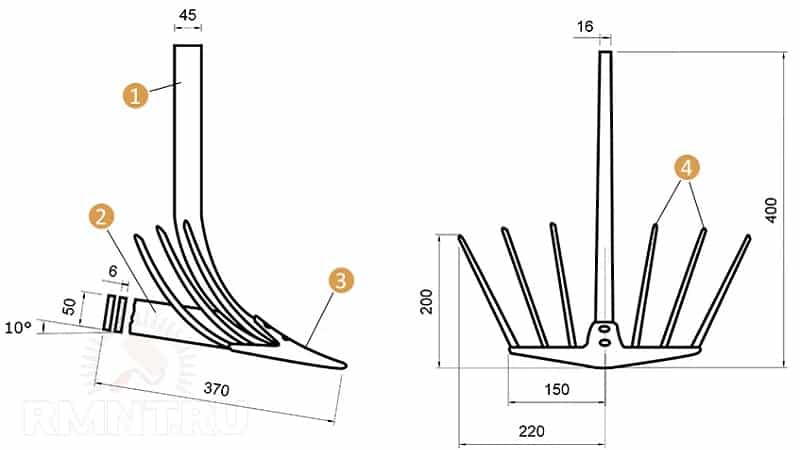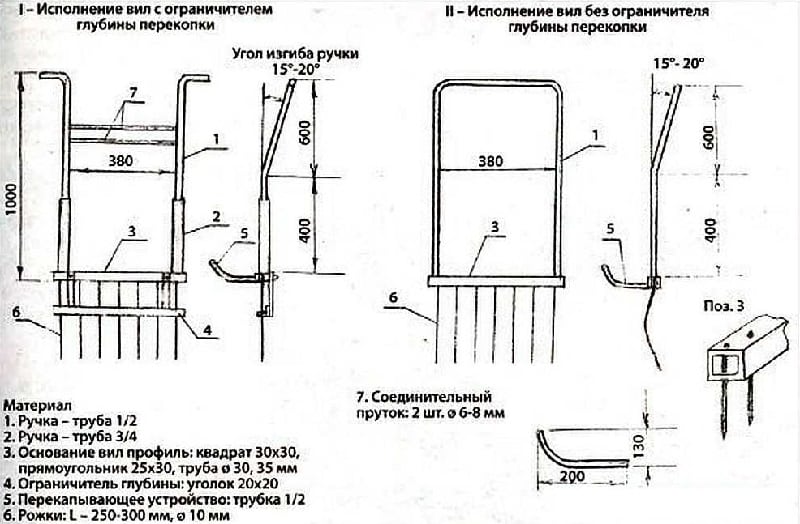Advantages of a manual potato digger and how to make it yourself
Harvesting is a troublesome and time-consuming task. Extracting potato tubers and various root crops from the ground manually involves a lot of physical effort, which somewhat overshadows the joy of getting a good harvest. Therefore, large farmers and amateur gardeners use various devices. In large areas where it is easy for machinery to turn around, tractors and monoblocks are used. In small gardens, potatoes are dug using a handmade homemade digger.
What is a potato digger
Different versions of this device allow, while unloading some parts of the body, loading others, stronger and more resilient. This makes work easier and increases productivity. Almost all designs of manual potato diggers are available for making at home.
Reference. With all the variety of design solutions for manual potato diggers, almost all of them are based on two leading principles: rotational and lever.
Device types
These devices based on the rational use of the muscular strength of the grower’s arms, legs and back, come in the form:
- “American” - combinations of a bayonet shovel with a shovel;
- the “Tornado” tool, based on the rotational actions of human hands;
- rotating forks, when, like a lever, the main forces are transferred from a person’s arms and back to his legs.
There are many modifications within these basic types of manual potato diggers, depending on the design abilities of the gardener, his technical and material capabilities.

Description
A manual potato digger in the form of a shovel (“American”) is similar to a regular bayonet shovel the only difference is that its canvas is somewhat deepened like a scoop. As a result, the tool not only cuts the ground, but also captures with its surface a large volume of soil with potato tubers.
Reference. “Americans” are distinguished by the fastening of the handle, which makes a smaller angle with the blade than that of a shovel, but does not run parallel to it, like a bayonet shovel. This design is most rational when digging vegetables.
The manual potato digger "Tornado", popular among farmers, does not look like a shovel. It is a sharp pin at the end of the handle, next to which curved long and sharp teeth are fixed. The pin is driven into the ground and the horizontal T-handle with curved handles is rotated 90°. The teeth go into the soil and bring the tubers to the surface. When working, the device allows you to avoid bending over and straining your lower back.
Various modifications of rotary forks are even more in demand among vegetable growers.. Thanks to the lever principle, they redistribute the main efforts when digging potatoes from the arms and back to the legs. The teeth of the device plunge into the ground and lift the tubers to the surface.
The algorithm for using such a potato digger is simple.:
- The tool is stuck into the soil next to the potato bush.
- One of the legs presses on the arc, completely burying the teeth into the ground.
- The handle on the right or left is tilted as low as possible.
- The cutting is returned to a vertical position.
- One of the legs presses on the resulting lever.
- As a result, the forks rise upward, removing the tubers from the ground.The soil crumbles between the teeth.
Besides that This potato digger reduces the strain on your arms and back, and is gentle on the vegetables themselves., because it undermines them from the side and below.

Interesting things on the site:
Instructions for creating a homemade potato planter
Main settings
The parameters of a manual potato digger directly depend on its design. The simplest of these, the popular swivel forks, have a working range of 0.3 m and an average weight of about 3 kg. High-strength steel is used for its manufacture. The teeth are made of metal rods with a diameter of 15–20 mm of round, square or hexagonal cross-section, the handle is made of wood.
Important! Since the device, made of metal and wood, often comes into contact with wet soil, store it in a dry room.
Advantages and disadvantages
The advantages of manual potato diggers include:
- increasing labor productivity;
- optimization and relief of physical activity;
- gentle treatment of potato tubers when removing them from the ground;
- the possibility of using them for digging other root crops, cultivating soil in the garden and in the garden.
A significant, but only drawback of such hand-held devices is the the need for physical effort.
Additional functions
Potato digging devices are used not only for harvesting, but also for planting plants. They are suitable as a cultivator for loosening the soil, getting rid of weeds and adding fertilizers to the soil.
Which is better: “Tornado” or “American”
“American” is an improved, but still a shovel, it has all the disadvantages of an ordinary bayonet shovel. They are aggravated by the greater load that is created by the recess in the canvas. In addition to straining your arms, legs and back, you have to constantly bend down to the ground to extract potato tubers from the earthen clod.
The Tornado manual potato digger has eliminated most of these shortcomings.. It does not require bending over either during operation or to remove potatoes from the soil, since the soil is removed through the teeth.

How to make a potato digger with your own hands: step-by-step instructions and drawing
It is quite possible for a craftsman who knows how to work with metal and has a welding machine to independently manufacture an effective manual potato digger.
The design of the device consists of several separate parts, which are collected one by one and then connected together:
- Making a ripper (see drawing below) from a rod with a diameter of 12 mm and a length of 67.7 mm, to which 8 rods of the same diameter and length of 280 mm are welded perpendicularly at equal distances. At the top, 2 corners No. 25 are attached perpendicularly, reinforced for rigidity with diagonally welded rods of the same diameter.
- Weld perpendicularly to a pipe 28x25x3 mm and 800 mm long 9 pieces of reinforcement No. 12, each 280 mm long, pre-sharpened and cleared of hard edges with a grinder. On the other side of the supporting pipe, handles made of pipes with a diameter of ¾ inches, each 1650 mm long, are attached perpendicularly to the rack. At a height of 1000 mm, they are bent 30° relative to the vertical towards the baking powder, where a pipe of the same diameter and 400 mm long is attached between them.The upper parts of the handles, 200 mm long, are bent at an angle of 90° in opposite directions.
- The pedal is made from 2 pieces of pipes 28x25x3 mm, 150 mm long. They are connected perpendicularly to a pipe with a diameter of ¾ inches and a length of 400 mm. At the other ends, a piece of reinforcement No. 12 of the same length is welded parallel to the pipe. At a distance of 200 mm from the first piece of reinforcement, another one is attached parallel to it. On top of the ends of the sections of rectangular pipes, sections of the same pipes, each 80 mm high, are attached perpendicularly.
- To the sides of the resulting pedal The ripper is secured with bolts.
- The structure is attached to the rest of the potato digger using curtains, some parts of which are welded to the handle posts, and the second to vertical sections of pipes on the pedal.
To make this effective manual potato digger with your own hands, a drawing is presented below:

Read also:
Review of potato planters for walk-behind tractor
Conclusion
The manual potato digger is so called by tradition, since many of its modern variants are based on the use primarily of legs. In any case, these tools involve human physical strength during operation. Reducing the load on it to a minimum, while increasing labor productivity, is the main task of such devices.
It takes a lot of effort to make a productive manual potato digger yourself, but it will certainly pay off in easier and even more enjoyable work in the garden.